The eruption began at 9.35pm with big heaves inside the crater. By 10.03pm it was pelting the nearby walking track with projectiles, but withheld its final energy until 10.11pm, when with a whoomph it sent a plume sky-high. A scalding current of steam and debris, coloured green by hydrothermally altered rock, rolled right across the track at 11m/s, and down to the south-eastern bays.
This eruption took place on Whakaari/White Island, New Zealand, on 27 April 2016, more than three years before the catastrophe in December last year that claimed the lives of 21 people (17 of them Australians) and injured 26 others.
Geologists from GNS Science, NZ’s leading provider of geoscientific research, reconstructed the pulses of the eruption from acoustic and seismic data, and, three weeks later when they could safely land on the island again, began figuring out the reach of those pulses.
The resulting scientific paper was published on 1 April last year, and its authors warned: “These eruptions clearly pose a significant hazard to the tourists that visit the island.” More than a quarter of the walking track had been bombarded by rock fragments. The pyroclastic surge, though just 5mm thick at its extremities, had nonetheless covered 95 per cent of the track.
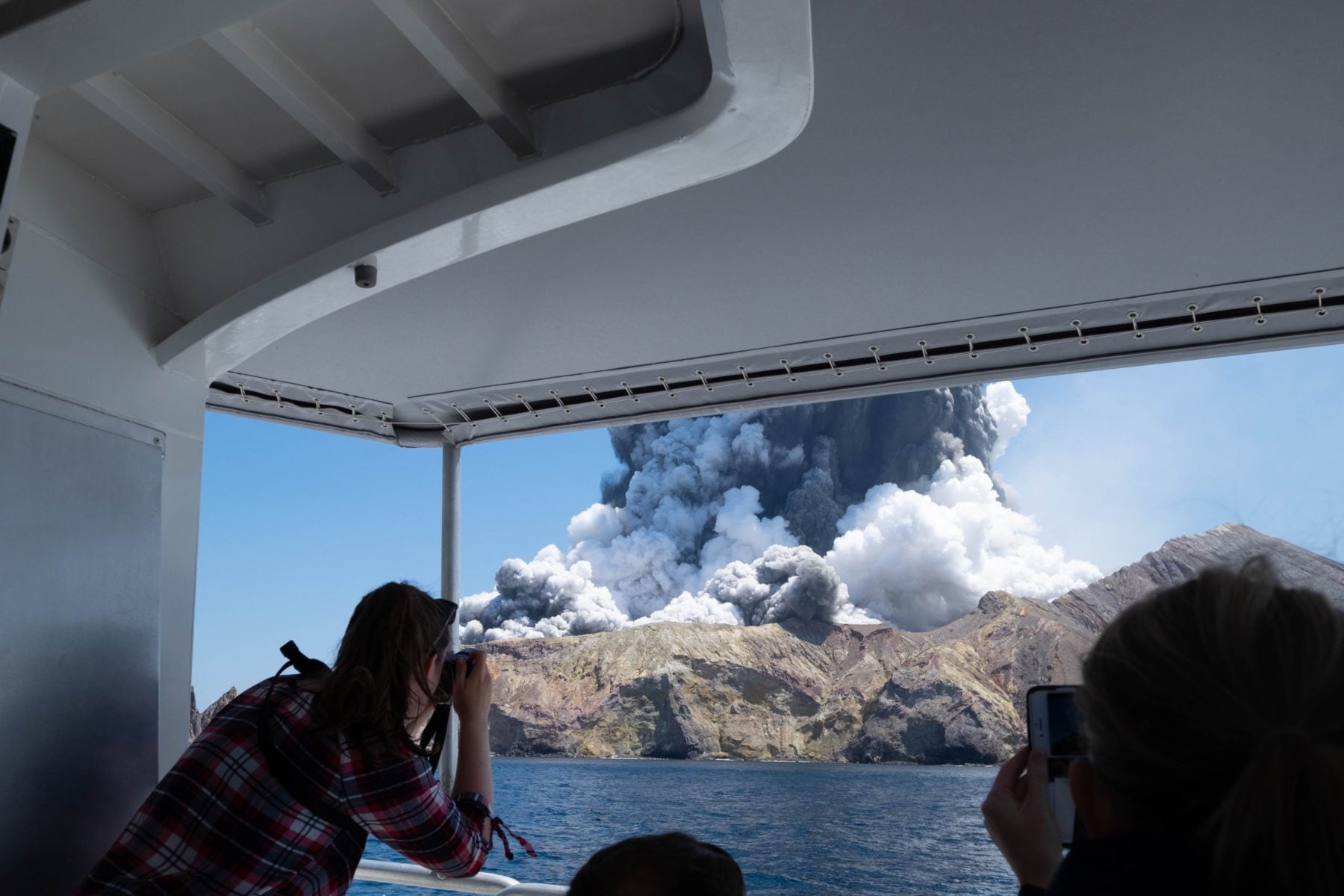
No warning
You might wonder if this eruption triggered any changes, but it happened at night, with no witnesses, so it simply passed on by. You might, therefore, be tempted to wish it into the daylight, when tourists would have been afoot, because then it might have garnered more notice – since it came in pulses of ascending violence, there would have been time to run, and the headlines would have been nothing more than “Tour operators reassess risk after near miss”. It would have been a wake-up call that produced only meetings over cups of tea, with scribbled notes, bottom-line business interests weighed against risk, and some kind of agreed reform.
Three years later, at 2.11pm on 9 December 2019, there was another eruption – one that came without warning. Except, perhaps, that on 8 December the instruments that measure tremors in nanometres momentarily spiked 30 per cent higher than any tremor during the previous two months. Or perhaps for a moment during a video shot by tourist Allessandro Kauffmann earlier in the afternoon. Kauffmann was part of the group aboard Phoenix, a White Island Tours vessel, and he videoed much of the island tour. At about 1.30pm, he panned along the hot, strangely bright stream flowing from the crater lake. Amid the snap and spit of boiling mineral water, the microphone caught an off-camera aside by a White Island Tours guide: “I’m a little bit worried why it’s going green.”
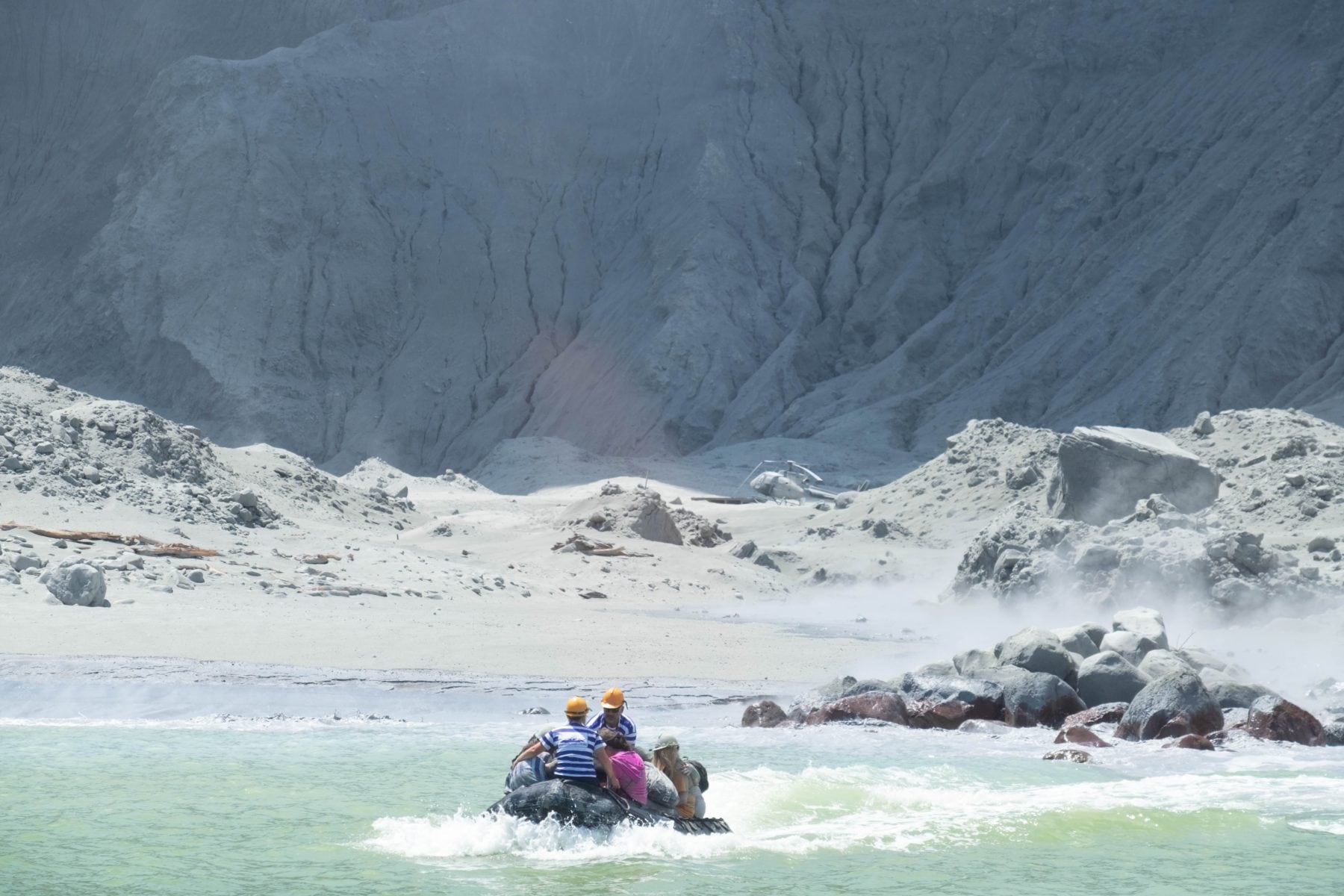
Whakaari’s dangerous charm
Attitudes to Whakaari have long been cavalier. In 1914 miners drained the crater lake to uncover deeper deposits of sulphur. Geologists suspect this affected the stability of the crater cliffs, because in September that same year, a 300m-wide chunk collapsed. As it fell, the rock, weakened by heat and saturated with water, mutated from an avalanche into a highly fluid lahar (a violent type of mud or debris flow), which ran for more than 1km eastward to the sea, burying the 11 miners and destroying the sulphur factory.
Then, during Whakaari’s long eruptive phase from 1976 to 1982, the keen young geologists of the NZ Geological Survey’s Rotorua office put together the first comprehensive analysis of the volcano’s mighty hydrothermal systems. They were often photographed as minute specks against vast up-rushing columns of steam, or in front of dark umbrellas of mud thrown up by the vents. They were out there for hours, measuring the gradual expansion or contraction of the crater floor, even when the volcano was – to use their word – “ashing”, the grey flakes coating their hair and clothes.
“We took risks and didn’t even think about it,” says Ian Nairn, who was one of that group. “We often went out straight after a serious eruption. It was our job, our interest, and the main problem was how long it took to organise a boat or a helicopter.”
Peter and Jenny Tait first became similarly transfixed by the volcano’s dangerous charm when they took a group from Germany on a fishing charter, but, at the Germans’ impulsive request, finished up exploring the island. The Taits built a business out of taking tourists to stand at the junction of the real world and the unruly energy of the underworld: the strange colours, the steaming lake, the crater cliffs painted bright yellow at their base and then rising almost vertically to 300m, cupping the humans below within a thrilling amphitheatre.
“That first trip was in 1990,” Tait tells me, “and, as it developed, Jenny and I were taking six people a day there. It was very personal. The reaction of the punters was, ‘It’s unbelievable,’ and that’s what drove us to keep developing it.”
In 2017 the Taits sold their business, White Island Tours – a 27-year-old enterprise that came with a motel and cafe – to Ngati Awa Group Holdings, which kept on many of the Taits’ employees.
“Safety?” Tait says, when asked about the potential risks of taking visitors to an active volcano. “We were more worried about the Whakatane River bar than the island erupting, to be honest. There were so many things. It was an adventure trip. You have to cross the river bar. You have to cross pretty rough ocean, then get into an inflatable and land, with very tricky conditions, to get onto the island at times. And you’re on the island a very short time, really. The overall chances of it erupting seemed pretty small.”
On the afternoon of 9 December, Tait was sitting in his lounge, high on the rocky ridge that overlooks Whakatane and out across 50km of blue ocean to Whakaari. He saw the eruptive column’s silent rise. He didn’t know if there were people on the island or not.
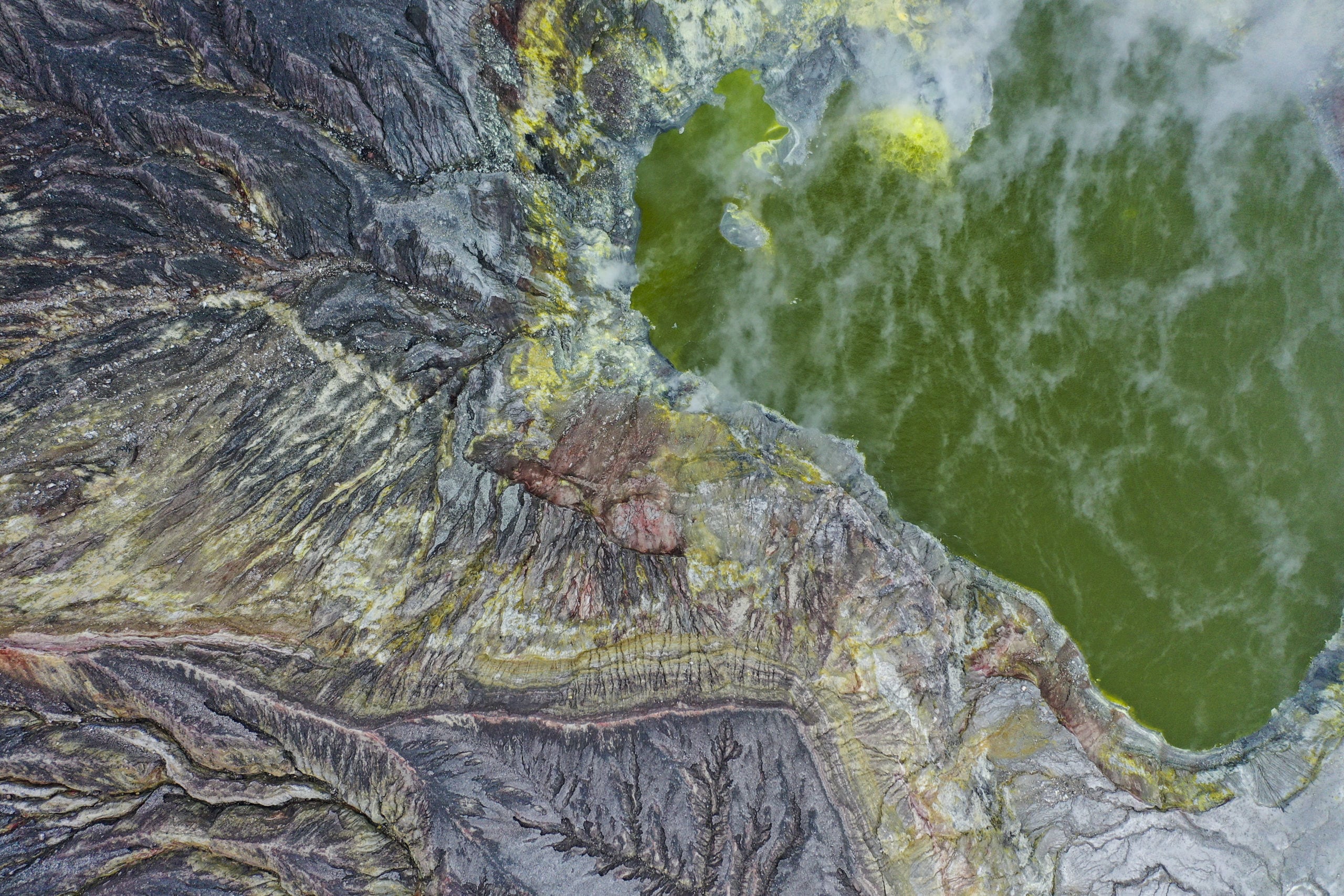
The rescue mission
Those aboard Phoenix knew. At about 2pm, passengers had returned to the vessel, which was moored in Te Awapuia Bay on the south-eastern corner of the island. Phoenix motored north around Troup Head, giving its passengers one last photo opportunity directly up the crater, before it turned south to return to Whakatane.
It was right at that moment, to gasps of pure wonder, that the eruptive column boiled into the sky. Then the column darkened at the base, and a sinister ground-hugging wave steadily overwhelmed the island, billowing towards the vessel. The framing on every camera went up, down or sideways, jerking with fear.
The skipper accelerated clear of the ash cloud, and for his passengers the eruption was no more than a terrible fright. But there were people on board who knew that White Island Tours’ new flagship vessel, Te Puia Whakaari, was still moored back at Te Awapuia Bay, and that its tourists were still on shore. That meant 38 passengers from the cruise liner Ovation of the Seas, plus four guides.
Meanwhile, the Rotorua-based company Volcanic Air had brought four tourists to the island on a Squirrel helicopter that the company’s pilot and guide had set down on a landing pad behind the ruin of the sulphur factory. That made 47 people still on the island.
At 2.14pm, Phoenix sent out an emergency call to Coastguard Whakatane, advising of an eruption and requesting urgent medical evacuation. Phoenix then sped back to Te Awapuia Bay, and called the coastguard again at 2.16pm, confirming casualties. Minutes later, Te Puia Whakaari also contacted the coastguard. The three calls triggered a Civil Defence emergency, alerting police, St John Ambulance services, rescue-helicopter services and hospitals on the mainland.
But Whakaari lay across 50km of rough ocean, far from any immediate help. As national agencies began to tool up, the locals were already organising their own ship-to-shore and air-to-ground rescues.
At Te Awapuia Bay, the ash had already cleared. The sky was once again blue and the sun shone, but Te Puia Whakaari and the island itself were a dull, flat grey. Phoenix’s skipper kept his engines running, ready to speed clear if the volcano blew again.
Paul Kingi was a senior skipper and the tours manager at White Island Tours, but he’d joined Phoenix that morning simply as a guide and was free of any captain’s responsibility to stay with the vessel. He took immediate charge of the rescue, loading two crewmates into Phoenix’s inflatable, then gunning its motor to intercept a woman swimming towards Te Puia Whakaari. After plucking another two women from the water, he took all three to Phoenix. Then he turned to the dozen or so people, grey with ash, who were huddled on or near the island’s landing.
As the sea-to-shore rescue got underway, an air-to-ground rescue was assembling. The rising plume from Whakaari had served as a shrill alarm for pilots from Whakatane, Rotorua and Taupo. Mark Law, head pilot of Whakatane-based helicopter operators Kahu NZ, saw the eruption as he drove back from Tauranga in his car. He got on the phone, and the Kahu base confirmed that GNS Science’s monitoring cameras on the island had blanked out. Simultaneously, high above the blue expanse of the Bay of Plenty, a helicopter pilot who had lifted off from Whakaari just six minutes earlier called his head pilot, Tim Barrow, at Volcanic Air, and described the scale of the eruption. Barrow then called Law.
Meanwhile, retired helicopter rescue pilot John Funnell was in the air in a small fixed-wing aircraft near Whakatane, keeping up his flying hours. As two Kahu choppers prepared to lift off for Whakaari, with pilots Law, Jason Hill and Tom Storey aboard, Funnell was enlisted as ‘top cover’, a specific role within emergency operations – the top cover is the fixed-winger that circles high above the scene and transmits information received from the team below.
So a small airborne unit was formed, bound together not by official roles or rehearsals, but by the natural meshing of grave concerns and aided by local knowledge of landing pads within the crater.
By then, the sea-to-shore rescue was closing up, and Phoenix had become a de facto hospital ship. Kingi’s inflatable had delivered the people on the landing to the vessel, including the four Volcanic Air tourists and their pilot. Three of those five were probably the luckiest people on the island that day, because when the volcano blew they were already at the shoreline, the last point of interest in their hour-long tour. The pilot urged them into the water, and he and the two who immersed themselves escaped serious injury. The other two hesitated, and were later hospitalised for burns.
Kingi, back on the island, had gone inland on the walking track towards the crater to find more survivors and help them down to the inflatable. The last person Kingi found, just as he had decided to stop searching, was 19-year-old Australian Jesse Langford, who stumbled down towards him. Jesse had been more than 300m inland when the volcano blew. He was his family’s only survivor, because his father, Anthony, mother, Kristine, and sister, Winona, passed away around him.
At about 2.45pm, Phoenix took off for Whakatane. The Kahu helicopters above and the vessel below crossed paths just before 3pm, and Law swooped low, the urgency of his mission and the scale of it confirmed by the sight of prone people being tended to on the back deck.
Those who had sustained the worst burns had been placed at the front of the vessel, and two doctors had stepped forward from among the passengers to tend to them – a general practitioner on holiday from the UK, and another from Germany.
Geoff Hopkins, a pastor at Arise church in Hamilton with a St John certificate, also provided assistance. He dug deep into remote first-aid training he’d done in the UK, but he was dealing with people drifting in and out of consciousness, people who were saying, “I’m not going to make it.” So he dug deeper yet, into his faith, and told them, “You’re not going to give up.”
His daughter, Lillani, was at the back of the vessel with the other victims, doing her best to stave off hypothermia and shock. She found herself singing the evangelical song “Waymaker”:
You are here – moving in our midst…
You are here – working in this place…
You are here – healing every heart…
And if she stopped there’d be a touch on her leg, and a whisper: “Keep singing.”
Halfway back, Phoenix was met by a coastguard vessel delivering paramedics and pain-relief medication.
About 3pm, the Kahu helicopters entered the crater airspace, and Law descended to 200 feet for a closer look. The centre of the island was now mostly clear of steam and ash. He saw some figures lying down, and others sitting – there were people alive down there. The Kahu pilots set their choppers down on the crater floor and got out of their machines, scuffing through the grey ashfall, amid dense gases and drifting ash.
Breathing was difficult, even with gas masks. They assessed the dead, the dying and the living. Through a handheld radio – they had to remove their gas masks to speak into it – they described injuries to Funnell, their top cover, who relayed the information to Whakatane Hospital.
The fliers felt the desperation in everyone they encountered, and their response was to talk back, to comfort, to tell each person, “We’re here. We’ll get you out,” before moving on to the next person. Law got word that the big air ambulances were still being staged at Whakatane, so any immediate rescue was up to them. The most badly injured – by ballistics as well as scalding – were those nearest the crater. The Kahu team hopped one of the choppers further up into the threatening miasma to get them, loaded five people, and Hill took off for Whakatane Hospital. Below him, out of the steamy cauldron that had produced the lethal blast, the volcano suddenly started ashing.
By now, it was about 3.40pm, and Barrow was settling his helicopter onto a landing pad by the shore. He’d flown in from Rotorua with pilot Graeme Hopcroft. Funnell had updated them on conditions, and they raced up to the crater to join the search. They half-carried one survivor to their chopper, then joined the Kahu crew to assist five more survivors into Law’s machine. Law lifted up and out for Whakatane. Barrow, Hopcroft and Storey loaded one more survivor into the
Volcanic Air helicopter, then Barrow and Hopcroft fired it up and banked south for Whakatane.
For a time, Storey was left alone. He spent the next half-hour grouping bodies for later retrieval. Among the bodies was his friend, White Island Tours guide Hayden Marshall-Inman. A second Volcanic Air helicopter arrived to pick up Storey, and completed an aerial reconnaissance of the crater.
By then it was all but over.
Two Westpac air-ambulance helicopters arrived, one circling on standby above the crater, while the second landed St John medical director Tony Smith and three other clinicians on the eerie domain below. They checked the bodies for signs of life, and confirmed no survivors were left behind.
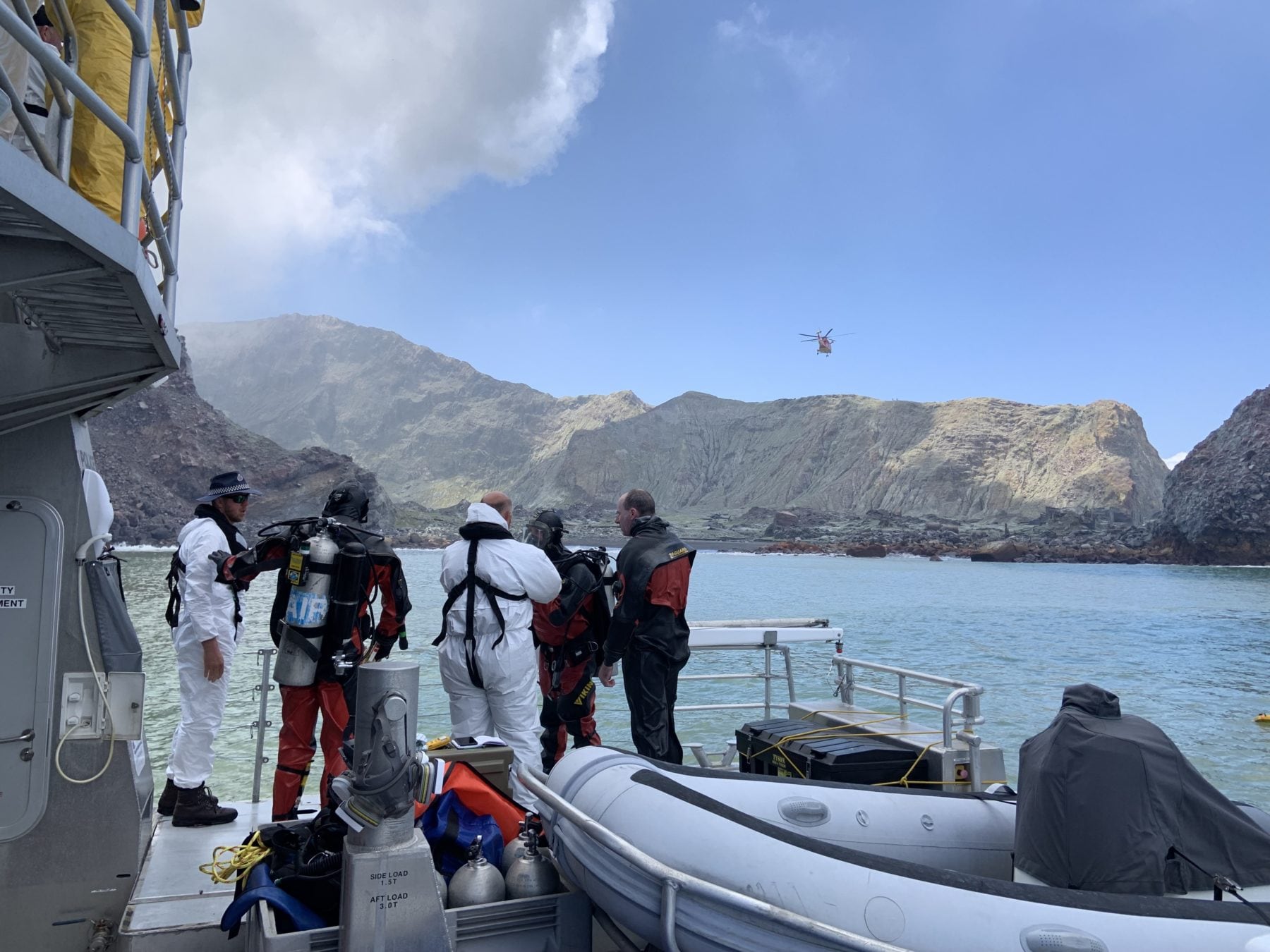
The science behind the eruption
In geological terms, the steam-driven eruption on 9 December was a small one, similar in energy and range to the 27 April event three years earlier. One significant difference was that it happened more quickly.
Shane Cronin, professor of volcanology at the University of Auckland, compares the 9 December eruption to a giant pressure cooker blowing its lid. Whakaari’s “lid” consisted of layers of sulphur, salts and weakened rock, which were metres deep. These were blasted away to form an entirely new vent. When this lid blew, a pressure wave fled across the island at supersonic speed, invisible but forceful enough to knock gas masks off the faces of tourists and guides and to shift Volcanic Air’s 1.3 tonne Squirrel helicopter half off its landing pad.
Then an eruptive column of steam and ash climbed into the sky, perilous to any who stood close by.
But the most lethal event in the eruptive sequence was the third: a dense, ground-hugging pyroclastic surge, which flowed from the vent, over the walking track and right down to the eastern shoreline.
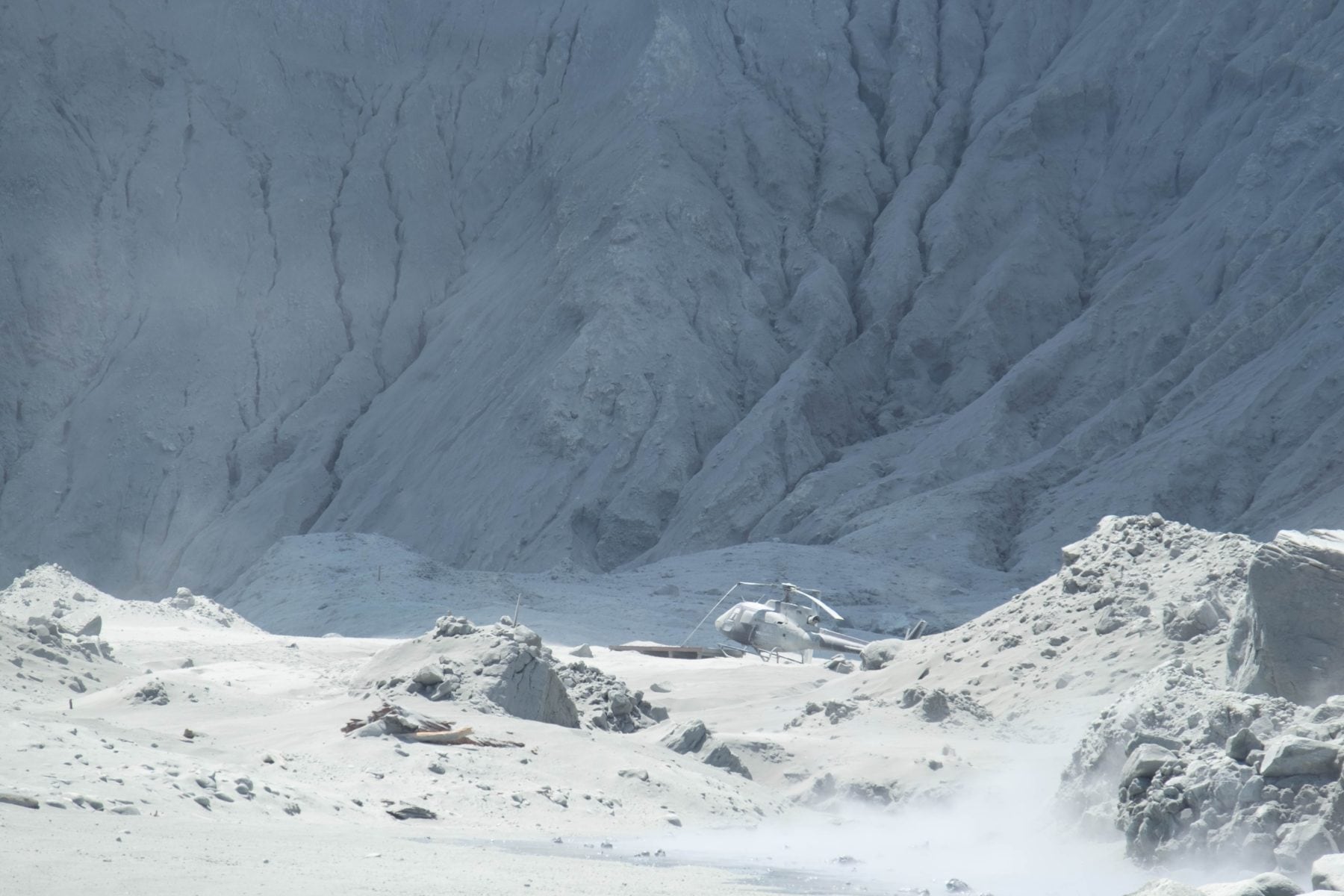
Cronin calculates from past studies of steam-driven eruptions on Whakaari that this surge would have burst from the crater at 300ºC and 100km/hour, losing force and heat in the ambient air as it rolled east. It was still boiling hot but had slowed to about 25km/hour when it flowed into the sea.
The surge was mainly formed of steam and ash, but carried within it a “salty aerosol”, says Cronin. Past testing of residues from this type of eruption has found them to consist mostly of fine fragments of pulverised rock coated in sulphur and acid salts, which turn into concentrated droplets of sulphuric acid when they come into contact with air, water or human skin. The remaining residues are hydrochloric acid and small amounts of hydrofluoric acid, which is the most corrosive of the residues, especially if inhaled.
Although the Squirrel helicopter was 1km away from the eruptive vent, its rotor blades flapped up and down like a bird’s wings in the turbulence of the pressure wave. Then the pyroclastic surge plastered it with ash. Afterwards, it sat stranded in the grey surrounds, grievously damaged, its carbon fibre and aluminium rotors broken and drooping, undone by nature’s power.
Calculating the devastation
The eruption had triggered a national emergency, and leadership had been formally handed to Bay of Plenty’s Civil Defence Emergency Management Group, with police the lead agency for search and rescue, and for recovery. The helicopter pilots had operated independently of the official system, but fell under its command once they landed and were stood down.
Eight bodies still lay on the island, two of them White Island Tours guides – Tipene Maangi and Hayden Marshall-Inman. As public pressure rose by the day to recover the Whakaari dead, Marshall-Inman became a symbol for all eight. The 40-year-old was well liked within the communities of Whakatane and Ohope, and he’d been with White Island Tours for many years.
A sense of frustration was growing in Whakatane, fuelled by outside control swooping in and sidelining local pilots, quarantining tour boats without properly cleaning them of corrosive ash, and suggesting – wrongly – that there was a criminal inquiry into White Island Tours. The town’s diffuse anger found focus on delays in the recovery.
But police were responsible for ensuring no further casualties, and the GNS Science seismometer on Whakaari was laying down a continuous recording of the volcano’s quivering energy.The volcano had erupted out of nowhere, and might do so again. In the hours after the eruption, the island was relatively quiet – and, in retrospect, this was the window for recovering the bodies.
Indications of unrest became more pronounced on Tuesday 10 December when the tremors began again, and on Wednesday and early Thursday the tremors peaked at levels well above the eruption itself. On Thursday evening, the tremors fell away sharply, and continued to fall on Friday, when the NZ Defence Force landed on the island at first light.
It was a team of eight, including six bomb disposal specialists, kitted out in three protective layers, with breathing apparatus and four hours’ worth of air. The work they did was exhausting. Around the active crater area, they waded through dense, hot, acidic mud, but they collected the bodies, and prepared them for final retrieval by helicopter to HMNZS Wellington, which was waiting offshore.
They recovered six bodies, but two had gone. Marshall-Inman and Winona Langford had been 800m away from the eruption, and 300m from the shoreline, but a violent rainstorm had swollen the stream near where they lay, and washed them into the sea. Police would later say that, while patrolling in Te Awapuia Bay, they’d seen a body believed to be Marshall-Inman near the landing, but couldn’t get close enough to recover it, and called in a Navy inflatable. In rebounding waves, the Navy personnel were unable to take the body aboard, and the rough sea allowed no second chance.
Resigned to the lack of any formal goodbye, the Inman family organised a celebration of life at the Whakatane Baptist Church on 20 December. Maangi’s photo was on display, too, and hundreds attended. The mourners heard from the helicopter-pilot rescuers that both Marshall-Inman and Maangi had tried to help members of their tour groups before they’d finally succumbed. Monday 9 December had been Marshall-Inman’s 1111th venture onto the island, and each one of them, except the last, had been recorded in his diary.
A few weeks later, Marshall-Inman’s brother Mark Inman and friends rode jet skis out to Whakaari, and sat on their craft in Te Awapuia Bay. After the long haul out to the island, the eight riders opened cans of beer and performed their own karakia – Maori incantations and prayers, used to invoke spiritual guidance and protection – to their friend and brother, and to all those who’d lost their lives.



